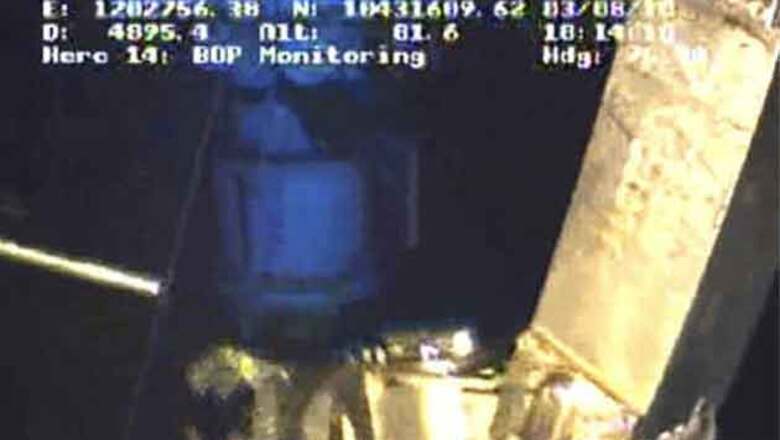
views
Washington: BP said on Wednesday it was close to subduing its ruptured Gulf of Mexico oil well, and the White House hailed the "beginning of the end" of efforts to contain the worst spill in the US history.
After months of setbacks in efforts to permanently plug the deep-sea well, BP said heavy drilling mud injected into it on Tuesday was stemming the flow of crude.
Following the initial success of its "static kill," the US authorities gave the company permission to begin cementing the well, though the permanent solution still lies in a relief well being drilled, which should be completed later this month.
BP said cement pumping is expected to begin on Thursday.
"The aim of the procedure is to assist with the strategy to kill and isolate the well, and will complement the upcoming relief well operation," it said.
The British energy giant, which has lost about 40 per cent of its market value and seen its image badly tarnished by the disaster, called its latest effort a "significant milestone."
"The long battle to stop the leak and contain the oil is finally close to coming to an end," said President Barack Obama, whose approval ratings have been hurt by public discontent over his administration's handling of the spill.
BP's mile-deep Macondo well ruptured after an oilrig exploded and sank in April, leaking millions of barrels of oil into the ocean for nearly three months in the world's worst accidental marine spill.
The static kill is part of a two-pronged strategy to kill the well for good. The relief well is seen as the final solution. After it intercepts with the ruptured well shaft, mud and cement will be pumped in to plug the oil reservoir 13,000 feet (4,000 metres) beneath the seabed.
Where's the oil?
As BP reported success in the Gulf, a team of government scientists said about 50 per cent of the spilled oil had been captured, evaporated, burned or skimmed, while another quarter had been naturally or chemically dispersed.
The rest was either on or just beneath the water's surface as "light sheen or weathered tarballs," had washed ashore or was buried in sand and sediments at the sea bottom, they said.
The financial implications for BP's continued cleanup efforts were not immediately clear. Government officials have said in the past that it will take years to fully repair the damage inflicted by the spilled oil, which seeped into ecologically sensitive wetlands and marshes.
Despite the good news from the Gulf, BP shares in New York slid 1.5 per cent amid apparent profit-taking by investors.
However, shares of Anadarko Petroleum Corp and Transocean Ltd companies that may face liability related to the oil spill, rallied, in part because of optimism that the static kill appears to be working.
Obama's energy adviser, Carol Browner, welcomed the scientists' report as a "turning point," but environmental groups were skeptical.
More than 1 million barrels of oil remains in the Gulf, four times the 257,000 barrels that spilled into Alaska's Prince William Sound from the Exxon Valdez tanker in 1989.
A senior government official said the amount of oil remaining on the surface of the ocean was "negligible", but she acknowledged that the dispersed oil, even in microscopic droplet form, was still highly toxic to marine creatures.
"We remain concerned about the long-term impacts both on the marshes and the wildlife but also beneath the surface and are actively studying that," said Jane Lubchenco, who heads the National Oceanic and Atmospheric Administration.
"The total amount of oil was immense and the impact is likely to be considerable even though Mother Nature is helping the federal effort," she said.
The National Wildlife Federation said hundreds of birds and sea turtles had been rescued or found dead in the first days of August, underlining the continued danger the oil poses.
"Our experience with previous oil disasters like the Exxon Valdez shows the full impact of an oil disaster may not be apparent for months or years to come," it said.
Containment to cleanup
White House spokesman Robert Gibbs said the focus was shifting from efforts to cap the well to the long-term plan to clean up the rest of the oil and restore the Gulf region.
"It is sort of the beginning of the end of the sealing and containment phase of this operation," said Gibbs.
But he and other government officials at the White House briefing stressed that the administration remained committed to the Gulf Coast. State officials and residents in the area have been critical of the administration's response to the crisis.
"There remains a lot to be done," said Browner. "While the first phase of closing the well may be coming to an end, there is another phase, which is the restoration. It is making sure these communities ... are made whole."
Democratic Senator Mary Landrieu, whose Louisiana state has been hard hit by the spill, said the crisis was far from over.
"The Gulf Coast needs significant investments for recovery and restoration, and we're going to hold BP accountable and we're going to hold the federal government accountable," she said in an interview.
The spill also disrupted the livelihoods of fishermen and tourism operators and triggered a barrage of damages lawsuits against BP, which has said it will pay all legitimate claims.
Earlier this week, government scientists reported that about 5 million barrels of oil may have leaked from the BP well before it was temporarily capped on July 15.




















Comments
0 comment